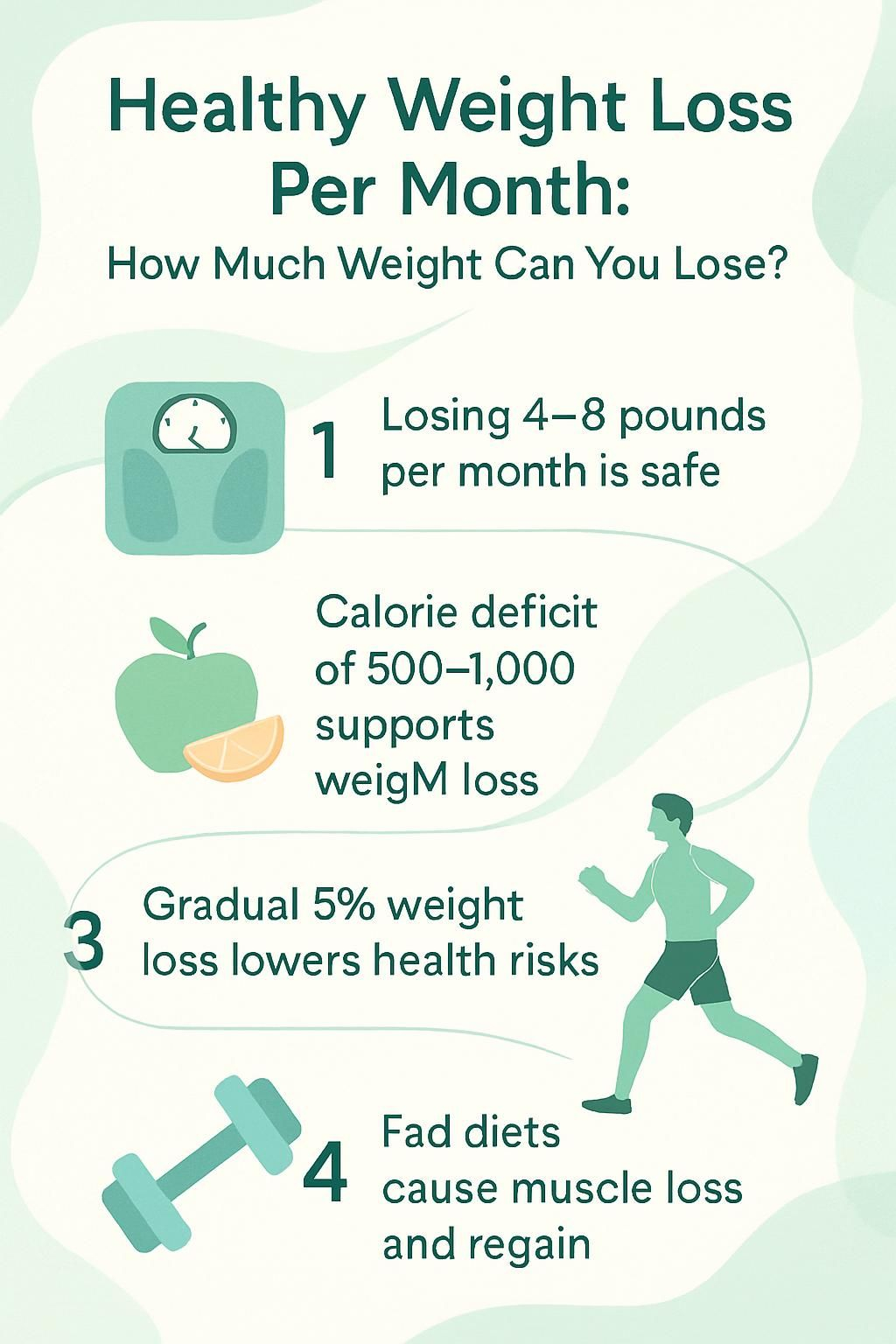Healthy Weight Loss Per Month: How Much Weight Can You Lose?
Our Nutrition Assistant AI Suite will transform your body. You will lose fat, get toned, and build muscle. Gain confidence and optimal health.
You want to lose weight and wonder what a safe pace looks like. Healthy weight loss means dropping about 1 to 2 pounds per week, or roughly 4 to 8 pounds each month. This pace supports long-term weight loss and protects your health.
This guide explains how much weight you can lose in a month, which factors affect progress, and why slow change works best. Learn the facts before you plan your next steps.
Key Takeaways
- The CDC and Mayo Clinic advise losing 1 to 2 pounds per week, or 4 to 8 pounds per month, for safe, realistic weight loss.
- A daily calorie deficit of 500 to 1,000, plus at least 30 minutes of exercise most days, supports steady monthly results.
- Losing 5% of your starting body weight can reduce risk for type 2 diabetes, high blood pressure, and heart disease.
- Fad diets and very low calorie intake can cause muscle loss, dehydration, and fast regain instead of lasting fat loss.
- Combining strength training and aerobic activity with nutrient-dense foods improves long-term success and boosts energy and mood.

What Is Healthy Weight Loss?

Healthy weight loss is slow and steady. Most experts recommend losing 1 to 2 pounds per week, or 4 to 8 pounds per month. The Centers for Disease Control and Prevention supports this pace because it leads to better weight loss maintenance.
You reach this rate with realistic changes to eating and activity. Focus on whole foods, regular movement, and practical habits rather than strict or trendy diets.
Even modest weight loss matters. Dropping just 5% of your starting weight can lower the risk of type 2 diabetes and high blood pressure.
New habits and a supportive mindset help you keep weight off. Tracking meals once led me to swap refined snacks for whole grains. Small daily choices build up over time.
“Even modest weight loss—like losing just 5% of your body weight—can yield significant health benefits.”
Knowing safe rates sets realistic expectations for how much you can lose each month.
Recommended Weight Loss Rates Per Month
Most health groups support a gradual pace for safety and lasting change. Clear monthly targets help you lose weight and keep it off.
What Are Safe Weight Loss Guidelines?
Guidelines from the CDC, Mayo Clinic, and the National Institute of Diabetes and Digestive and Kidney Diseases point to 1 to 2 pounds per week. That equals 4 to 8 pounds per month.
This rate reduces body fat while protecting muscle and energy. Shift your eating pattern toward vegetables, whole grains, and lean proteins. Cut back on added sugar and highly processed foods.
Pair eating changes with aerobic exercise and strength training to support muscle. If you have medical conditions, take medications, or hope to lose a large amount, talk with your doctor.
Following these steps, I lost 10 pounds in two months and found it easier to maintain than past crash attempts. Realistic goals keep you motivated and support long-term results.
How Much Weight Can You Expect to Lose Weekly?
Expect about 1 to 2 pounds, or 0.5 to 1 kg, per week if you follow a healthy plan. The American Heart Association often cites a daily calorie deficit of 500 to 750 as a practical target for most adults.
Losing more can raise the risk of muscle loss, dehydration, and fast regain rather than true fat loss.
Weekly losses will vary. Plateaus are common due to water shifts, metabolic changes, or tracking errors. Some weeks drop more, others less, even with consistent effort.
Healthy weight reduction happens gradually—aiming for one to two pounds per week helps you achieve your goal and maintain your health.
Factors That Affect Weight Loss
Weight change depends on more than calories. Age, metabolism, starting weight, physical activity, and your diet all shape progress.
How Do Age and Metabolism Influence Weight Loss?
Metabolism is how your body turns food into energy. It tends to slow with age, which can make weight loss harder if eating habits do not change. The body may burn fewer calories at rest and during activity.
Hormonal shifts can also change fat storage. Older adults often store more fat around the abdomen, which raises risk for heart and blood pressure issues.
Adjusting your diet and activity can help. Choose nutrient-dense foods, plan balanced meals, and move daily. A registered dietitian can tailor strategies to your age and current weight.
How Do Starting Weight and Body Composition Affect Results?
Starting weight and body composition play a big role. People with higher starting weight often see faster early losses because a larger body needs more energy to maintain.
Muscle mass matters too. Muscle burns more calories at rest than fat. Rapid diets that reduce muscle can slow your metabolism and make long-term weight management harder.
To protect muscle, include strength training and eat enough protein. This keeps most of your loss coming from fat stores, not lean tissue. Many health experts in the United States suggest combining resistance training with aerobic workouts in any effective plan.
What Role Does Physical Activity Play in Weight Loss?
Physical activity increases calorie burn and supports weight control. Aim for at least 30 minutes of exercise most days to boost your deficit and support safe weight loss.
Strength training twice weekly helps you lose fat while keeping muscle. Small changes count, like taking the stairs or walking during TV breaks.
Evening walks helped me reach step goals and unwind with friends. Long-term maintenance improves when regular activity is part of your routine.
How Does Diet and Caloric Intake Impact Weight Loss?
A calorie deficit means eating fewer calories than you burn. Most experts suggest 500 to 1,000 fewer calories per day to lose about 1 to 2 pounds per week, or 4 to 8 pounds per month.
Swap processed foods and added sugars for more plants and whole grains. This supports steady energy and fewer cravings by keeping blood sugar levels more stable.
Choose nutrient-dense foods to meet vitamin and mineral needs while cutting calories. Use portion control and mindful eating to prevent overeating.
A simple food diary helped me spot hidden calories in snacks that seemed healthy. Try filling half your plate with vegetables and include lean protein to stay satisfied without overshooting calories.
Strategies for Healthy Weight Loss
These proven strategies help you lose weight safely while supporting health and daily life.
How Can You Create a Caloric Deficit?
A daily deficit of 500 to 750 calories is standard for steady weight loss. This pace usually leads to 1 to 2 pounds per week and 4 to 8 pounds per month.
Track what you eat and drink. Logging meals reveals hidden calories and shows where to adjust.
- Trade sugary drinks for water or unsweetened tea.
- Build meals from fruits, vegetables, lean protein, and whole grains.
- Cut energy-dense snacks that add calories without nutrients.
I used a free app to log meals. Seeing the numbers made it easier to change habits. For instance, trimming 250 calories from food and burning 250 more through activity meets a 500-calorie daily target.
What Are the Benefits of Regular Exercise?
Exercise raises daily calorie burn and helps keep lost weight off. Many people succeed with at least 30 minutes of aerobic activity most days and strength training two times per week.
Short choices add up, like taking stairs or walking during calls. Cardio also helps reduce abdominal fat and supports heart health.
After I started evening walks, I slept better and felt less stressed. Activity can also lower cholesterol and reduce risk for chronic conditions such as prediabetes. Nutrient-dense foods enhance these benefits.
Why Are Nutrient-Dense Foods Important?
Nutrient-dense foods deliver vitamins, minerals, fiber, and protein with fewer calories. Aim for at least four servings of vegetables and three servings of fruit each day to stay full while keeping intake in check.
Whole grains like brown rice or whole wheat bread offer steady energy. Healthy fats such as olive oil and nuts improve satiety and help control hunger, which supports weight management.
Building your pantry around fresh produce, whole grains, and plant-forward options can reduce risk for chronic diseases linked to poor diet, including obesity and high cholesterol.
How Does Hydration Affect Weight Loss?
Water helps your body process fat and prevents dehydration. Rapid losses on very low carb plans often reflect water loss, which raises dehydration risk.
Well-hydrated kidneys work better. Drinking water before meals can reduce extra snacking by improving fullness.
Replacing sugary drinks with water lowers calorie intake. Complex carbohydrates, such as oats and beans, help with steady hydration and provide lasting energy for activity.
My progress steadied once I drank a glass of water before each meal. Hydration is a simple step that supports weight loss and maintenance.
How Do Stress and Sleep Influence Weight Loss?
High stress and poor sleep can slow progress even with a healthy diet. Stress often drives cravings for sugary or salty foods, which raises calorie intake.
Many people who report high stress also regain weight due to emotional eating. Support groups, brief journaling, or counseling can help manage stress in healthier ways.
Short sleep can raise hunger hormones and lower self-control. Keep a consistent sleep schedule, avoid late caffeine, and limit screens before bed. A consistent bedtime routine helped me feel more rested and more consistent with my goals.
How to Set Realistic Weight Loss Goals
Clear goals build momentum and protect your long-term health. Planning turns big hopes into daily actions.
Why Are Attainable Goals Important?
Very aggressive goals, such as losing 20 pounds in two weeks, often lead to frustration. A target of 5% weight loss is realistic and brings major health benefits.
Small milestones keep you motivated and confident. For example, aim to lose 4 to 8 pounds in a month instead of setting extreme targets. Steady progress helped me make healthy choices week after week.
How to Balance Immediate Results with Long-Term Health
Quick results can feel exciting, but fast loss rarely lasts. A steady 1 to 2 pounds per week aligns with medical guidance and protects your metabolism and muscle.
Very low calorie plans might show fast drops, but they raise the risk of muscle loss and low energy. Focus on daily habits that lead to durable change. Celebrate more than the scale, such as better strength and improved mood.
Gradual progress helps you maintain weight loss and avoid risks linked to extreme methods. Attainable goals also support a healthier mindset.
What Are Common Weight Loss Myths?
Misleading claims about rapid weight loss and miracle plans can derail your progress. Knowing the myths keeps your goals realistic.
What Is the Difference Between Rapid and Sustainable Weight Loss?
Rapid loss usually reflects water and muscle, not just fat. The scale may drop fast, but most of it is not lasting fat loss.
Drastic restriction can trigger a survival response that slows your metabolism. Many people who lose weight very quickly regain it just as fast.
Sustainable loss protects muscle and targets fat. A consistent, moderate deficit supports long-term success. For me, small weekly changes were far easier to maintain than big swings.
Experts advise losing 1 to 2 pounds per week, or 4 to 8 per month. This increases your chance of keeping the weight off.
What Should You Know About Fad Diets and Expectations?
Fad diets often promote quick fixes and cut entire food groups. Early drops are mostly water, not true fat loss.
Such plans are hard to sustain. Studies show strict and hyper-restrictive eating can slow metabolism and raise the risk of regain. Many end up heavier than before.
As a teen, I tried many quick solutions. Each short-term drop turned into disappointment once old habits returned. Treat eating as a lifestyle, not a temporary fix. This mindset supports healthy expectations about how much weight you can lose in a month.
Which Diet Plans Are Effective for Weight Loss?
Many plans promise fast results. A few patterns have strong evidence and can fit different lifestyles.
What Are the Benefits of the Mediterranean Diet?
The Mediterranean diet centers on plants, whole grains, and healthy fats such as olive oil and nuts. You eat more vegetables, fruits, beans, and seeds. Red meat and highly processed foods are limited.
This pattern supports gradual weight loss and lower disease risk. A 2019 analysis found followers had about a 25% lower risk of heart disease compared with non-followers.
Healthy fats can improve cholesterol. Whole grains increase fullness, which guides portion control. Swapping butter for olive oil made my meals tastier and supported steady control of weight.
How Does a Plant-Based Diet Aid Weight Loss?
Plant-based eating is usually lower in calories and higher in fiber than diets rich in animal products. Fiber slows digestion and supports fullness, which naturally lowers intake.
Aim for at least four servings of vegetables and three of fruit per day. Beans, lentils, berries, and leafy greens fill your plate and make meals satisfying.
Many studies show plant-forward diets can improve weight management compared with plans high in processed foods or animal fat.
Is a High-Protein, Low-Carb Diet Effective?
Higher protein intake helps preserve muscle while losing weight. Many trials show that high-protein, lower-carb diets can reduce fat faster than some standard plans, especially at first.
Early drops may include water loss, so hydrate well. Some people may lose 4 to 8 pounds in the first month, with part of that from water. Those with obesity may see faster early results than people closer to goal weight.
Focus on whole foods and monitor how you feel. If you have health concerns, consult a nutrition expert before making big changes.
How Does Exercise Help With Weight Loss?
Exercise burns calories, protects muscle, and improves health. A simple plan can move the needle on the scale.
What Is the Role of Strength Training in Weight Loss?
Strength training preserves and builds muscle, which burns more calories at rest than fat. Aim for at least two sessions per week that target all major muscle groups.
Keeping muscle helps maintain a higher metabolism as you lose fat. With only calorie cutting or cardio, you risk losing muscle, which can slow progress and raise regain risk.
Many trainers suggest free weights or resistance bands for legs, arms, chest, back, and core. I started with short sessions of squats and push-ups twice weekly plus nightly walks. After several weeks, my clothes fit better and daily tasks felt easier.
In short, strength training twice a week helps prevent muscle loss and supports steady monthly weight loss.
How Do Cardio Workouts Support Weight Loss?
Cardio workouts like brisk walking, swimming, and cycling raise calorie burn during each session. Try for at least 30 minutes on most days if your goal is steady monthly loss.
Keeping your heart rate up helps the body use stored fat. Combined with healthy eating, cardio creates a calorie deficit, which drives weight reduction. Regular activity also improves mood and reduces stress, which helps you stay consistent.
Why Combine Different Types of Exercise?
Aerobic activity burns calories, while strength training builds and preserves muscle. Doing both maximizes fat loss and supports a higher metabolism.
Alternate cardio and lifting days to balance recovery. Many experts recommend 150 minutes of moderate aerobic exercise plus two strength sessions per week.
Mixing routines also prevents boredom and can break plateaus. Seeing improvements in stamina and strength can keep you motivated month after month.
Benefits of Losing Weight Healthily
Healthy weight loss improves health, lifts energy, and can make daily routines feel easier.
How Does Weight Loss Improve Overall Health?
Losing just 5% of your body weight can improve blood pressure and cholesterol. It can also improve blood sugar control and reduce the need for some medications.
Research links even modest loss with lower risk of heart disease and type 2 diabetes. Many people also report feeling more energetic and less short of breath.
After a few pounds came off through better eating and regular walks, my lab results showed lower cholesterol. Changes on the scale can influence heart and metabolic health in meaningful ways.
Can Weight Loss Boost Energy and Mood?
Improving nutrition and moving more can raise energy and support mental well-being. As your body works more efficiently, routine tasks may feel easier.
Less strain on joints and better sleep can lift your mood. Many people report feeling happier as they build healthier routines.
When I lost 10 pounds over two months with balanced meals and daily walks, afternoon fatigue faded and mood swings eased. Staying hydrated also helped me focus during the day.
How Does Weight Loss Reduce Chronic Disease Risk?
Losing 5% to 10% of your starting weight can lower risk for heart disease and type 2 diabetes. It can improve blood pressure, cholesterol, and blood sugar control.
Reaching and maintaining a healthy weight protects against stroke and some cancers. In my work with patients after bariatric surgery, many needed fewer medications as they continued steady loss.
Safe weight loss helps manage current conditions and lowers the chance of new issues later in life.
What Are Signs of Unhealthy Weight Loss?
Unhealthy weight loss can harm muscles, mood, and long-term progress. Spotting early signs helps protect your health.
What Are the Risks of Extreme Calorie Cutting?
Severe calorie cuts often lead to muscle and water loss instead of steady fat loss. When intake is far too low, the body slows its metabolism to conserve energy.
Eating fewer than 1,200 calories per day can cause quick drops at first, then fatigue and poor mood. Very low carb diets paired with extreme cuts can increase dehydration and stress the kidneys.
Other risks include dizziness, irritability, weakened immunity, and gallstones. I once tried an overly aggressive plan and felt foggy while losing more muscle than fat. Safer loss is 1 to 2 pounds per week with an appropriate calorie intake.
How Can Excessive Exercise Be Harmful?
Too much exercise without enough fuel or rest raises injury risk and can lead to overtraining. Warning signs include constant fatigue, mood changes, and frequent illness.
Over-exercising, especially with low protein intake, can cause muscle loss and slow your metabolism. I once trained twice daily while cutting calories hard. Within two weeks, I was exhausted and hurt my knee. Balance protects progress.
What Is the Psychological Impact of Weight Loss?
Weight loss can lift confidence for a while, but rapid and unsustainable plans often lead to disappointment and negative body image. Many people blame themselves even though social pressures and ads shape expectations.
Regain is common, which can hurt self-esteem. Research from 2022 suggests that most people who lose weight regain it within five years. If mood or body image becomes a concern, reach out to a professional, especially if you have tried surgery or strict plans before.
When to Get Professional Help for Weight Loss
Expert guidance can make your plan safer and more effective. Care teams can help you set targets for how much weight you can lose each month.
When Should You See a Nutrition Expert?
See a registered dietitian if you feel stuck, have complex health needs, or want a personalized plan. Dietitians can adjust meals for conditions like diabetes, heart disease, or food allergies.
If you are losing too quickly or not at all, seek help. A dietitian once taught me portion sizes and nutrient balance for my body, which made progress possible.
What Medical Weight Loss Options Are Available?
Prescription medications can help some adults. Options include orlistat, phentermine-topiramate, bupropion-naltrexone, and GLP-1 agonists such as semaglutide. GLP-1 medicines reduce appetite by acting on gut and brain signals.
Many clinics offer programs with meal plans, coaching, and health checks. Your provider can monitor progress and adjust treatment.
With weekly check-ins and a prescription, I lost fifteen pounds in six months without feeling deprived. These options are not for everyone, but they can help if lifestyle changes alone are not enough.
If medications and structured programs fall short, your doctor may discuss surgery.
When Is Bariatric Surgery Considered?
Bariatric surgery may be considered for severe obesity when other methods have not worked. Typical criteria include a BMI of 40 or higher, or 35 with a related condition such as diabetes or sleep apnea.
A care team reviews your physical and mental health before surgery. Talk through risks and benefits, and discuss expected weight loss and lifestyle changes after the procedure.
How to Maintain Weight Loss Long-Term
Lasting results come from steady habits and simple systems that fit your life.
How to Build Lasting Healthy Habits
Start small and stay consistent. Meal plan once a week, schedule movement daily, and set reminders that support your routine.
Prepare healthy snacks so busy moments do not derail your plan. Good sleep and stress management also support appetite control. Studies show adults who get 7 to 9 hours have better hunger hormone balance compared with short sleepers[^1].
Drink water throughout the day to prevent mistaking thirst for hunger. Structure helps new habits stick.
Tracking progress can keep motivation high and reveal what works best for you.
…
[^1]: Spiegel K et al., Annals of Internal Medicine, 2004
How Can You Track Progress and Stay Motivated?
Use a journal or app to log meals, steps, workouts, sleep, and stress. Tracking builds awareness and helps you problem-solve sooner.
In a Kaiser Permanente study from 2008, people who kept food diaries lost about twice as much weight as those who did not. Reward milestones with non-food treats, such as a movie night or a rest day.
Graphs in my calorie app showed small wins even when the scale stalled. Seeing those trends made it easier to stay on track.
What Are Effective Ways to Prevent Weight Regain?
Plan for setbacks. Write a weekly strategy for cravings, travel, or schedule changes.
Join a support group or work with a registered dietitian for accountability. People who get professional help are more likely to maintain weight loss.
Keep logging meals and activity to spot patterns before they grow. Surround yourself with supportive peers. Encouragement raises your odds of long-term success.
Conclusion
Healthy weight loss takes patience and steady habits. Aim for 1 to 2 pounds per week, or 4 to 8 pounds per month. Build a modest calorie deficit, eat balanced meals, and move most days.
Track your actions, set realistic goals, and focus on small wins. Even a 5% loss can improve blood pressure and energy. If you have medical conditions or take medications, talk with your doctor or a registered dietitian for guidance. This article is for general information only and does not replace medical advice.
With a supportive mindset, good nutrition, stress control, and solid sleep, you can lose weight and maintain it. Celebrate steady progress as you build habits for a healthier future.
FAQs
1. How much weight can a person lose in one month safely?
Most health experts agree that losing 1 to 2 pounds per week is safe and sustainable. This means a healthy weight loss per month ranges from about 4 to 8 pounds, according to the Centers for Disease Control and Prevention (CDC).
2. What factors affect how much weight someone can lose each month?
Several elements influence monthly weight loss, including starting body size, age, sex, physical activity level, calorie intake, and metabolism rate. Medical conditions or medications may also play a role.
3. Is rapid weight loss unhealthy?
Losing more than 2 pounds per week often leads to muscle loss instead of fat reduction; it may also increase the risk of gallstones or nutrient deficiencies as shown in clinical studies published by the National Institutes of Health (NIH). Gradual changes are safer for long-term success.
4. Can personal experience help guide healthy weight loss goals?
Personal stories often highlight that setting realistic targets helps maintain motivation and prevents disappointment. For example, after tracking food choices and exercise habits over several months I noticed steady progress with small weekly losses rather than dramatic drops; this approach made it easier to keep the results over time.
Summary: Healthy monthly weight loss typically ranges from 4 to 8 pounds when following evidence-based guidelines. Individual differences matter so gradual progress supports lasting change while reducing health risks linked with quick fixes or extreme diets.







